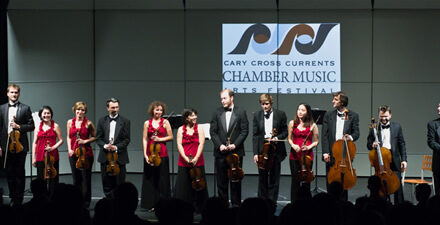 The emergence of outstanding string quartets composed of relatively-young musicians is surely a Good Thing for chamber music, as well as for music in general. In my young years, attending concerts at the Library of Congress, the Budapest and Juilliard quartets left the impression that such ensembles required more senior players. While this impression was already changing when the Tokyo and Guarneri quartets became leading exponents of the genre, we are indeed fortunate to have so many younger players making a good living from quartet playing.
The emergence of outstanding string quartets composed of relatively-young musicians is surely a Good Thing for chamber music, as well as for music in general. In my young years, attending concerts at the Library of Congress, the Budapest and Juilliard quartets left the impression that such ensembles required more senior players. While this impression was already changing when the Tokyo and Guarneri quartets became leading exponents of the genre, we are indeed fortunate to have so many younger players making a good living from quartet playing.
Chamber Music Raleigh has found a way to enable live performances even as the global pandemic continues to limit such events. Can’t assemble inside? No problem. Have the concerts outside. Audience numbers limited? No problem. Schedule duplicate programs, two hours apart. Worried about sonic competition from passing traffic? No problem. Book the event in a park far enough away from busy roads. Bothered by nearby park-users playing their own instruments at the same time? No problem! Just bribe them to stop for a while!
And so, it came to pass that the Attacca Quartet, winner of the 2020 Grammy award for best album by a quartet or small ensemble, played on Easter Day in Cary, N.C.’s Ritter Park in the center of a large pavilion with a beautifully-curved wooden ceiling, over a cement floor. Because they had to play the program twice (at 1:00 and 3:00 PM), their program had to be shortened by the elimination of a Haydn quartet, leaving two contemporary works plus the evergreen Ravel Quartet in F repertory staple.
The program: Caroline Shaw‘s “Entr’acte,” Jessie Montgomery‘s “Strum,” and Maurice Ravel’s Quartet in F. For distinctive program notes by CMR President Elizabeth Kahn and Joseph Kahn (which were unfortunately not available to the audience in printed form), see here.
Why “plus que ça change” (the beginning of the adage, “The more things change, the more they remain the same”)? Shaw’s work intentionally incorporates musical elements from earlier times. Her 2011 “Entr’acte,” in form a menuet + trio, uses a rhythmic motif which serves as a ritornello, a Baroque harmonic sequence, and division of instrumentation into solo-plus-accompaniment at times. All these elements may be found in Ravel’s 1903 quartet. To be sure, Shaw, herself an excellent violinist, uses string techniques of our own times such as pizzicato-glissandi, cats-in-contemplation (quiet mewings), and even silence to remind us that musical ideas are ongoing, never frozen in time; but, without imitating them, she builds her music using some of the same bricks and mortar used by earlier composers. While the musical elements of “Entr’acte” seem more disjunct than most of her more recent compositions, they perhaps hold our attention all the more because the relationship of one to another is not instantly apparent. We await with anticipation more music from Attacca’s on-going collaboration with N.C. native Shaw.
Montgomery’s “Strum” shows similar characteristics. We heard Copland-esque hoedown music, with two players strumming their fiddles held horizontally in their laps while solo melodies in violin and cello take wing. There is even a fugue, played pizzicato. Newer elements appear as Montgomery expands the roles of the four musicians, treating the ensemble in numerous combinations. The closing prestissimo coda brought roars of delight from the appreciative audience. Attacca lived up to its name in the vigor with which they “attacked” the more boisterous parts of Montgomery’s work; they clearly enjoyed it, as did those who listened.
Ravel’s quartet was the magnum opus of the afternoon, its four movements consuming some fifty percent of the program’s time. It was fascinating to hear the melodic ritornello, the rhythmic motifs, the melodies-with-accompaniment after hearing their counterparts in the contemporary works. If any doubt the inter-relationships between various art forms, let them listen to the third movement of this quartet, where Ravel’s music, with its shimmering tremolandi effects, conjures up images of his contemporary Claude Monet’s floating lily-pads.
In all this music, the Attacca Quartet proved themselves masters of all they surveyed. From the largest sounds to the almost-inaudible musings, they shared the delights of these disparate works with verve and virtuosity. Even the smallest things were played with care: a simple two-note bass motif in Ravel was caressed by cellist Andrew Yee, their eyes closed and head tilted towards the ceiling, making those two-note motifs more than just bass harmony, but rather two living pulses which had much to contribute to the whole.*
Thanks to Chamber Music Raleigh for letting us hear live music again – it’s been a long, long time; this performance was worth waiting for.
*The other artists are violinists Amy Schroeder and Domenic Salerni and violist Nathan Schram.











